In this Newsletter: tomato seedlings, seed compost for seedlings, recommended bush varieties, watering and feeding tomato seedlings, leggy seedlings, using a seed tray and pH for tomato seedlings.
This weekend I’m going to sow my main crop of tomatoes. This is around the time I like to sow, and the urge to start has become overwhelming. It is such a thrill when the first tomato seedlings come through!
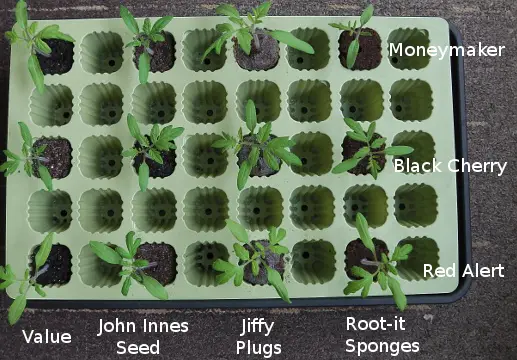
Some seasons ago, I did a test using different media, from cheap compost to Root-it Sponges and the results are in the photo above. There is not a lot of difference but I would suggest that the value compost (least expensive) is best avoided.
Seed compost
The one thing I like about using seed compost is being able to prick out the seedlings and transplant them lower in their next home – down to their seed leaves. To do this with Jiffy’s and sponges is difficult, unless you have a deep pot for the next transplanting stage.
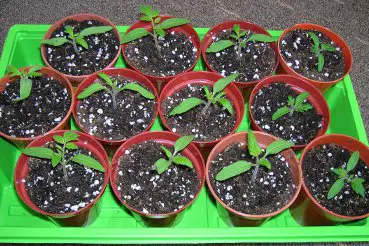
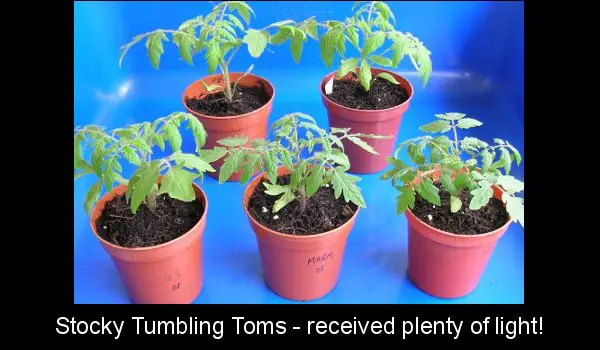
Tumbling Tom, Terenzo F1, Tumbler F1 and Lizzano F1
Tumbling Tom is a bush variety (photo above) that usually remains a nice stocky young plant and is ideal for a hanging basket or large pot or container.
My preference is Terenzo F1 (an upgrade of Tumbler F1) for hanging baskets but if you want to get a great crop of cherry tomatoes grown in a large pot or container try Lizzano F1. Give it plenty of room for maximum results and it is blight resistant too!
Of course I still rate the old favorites of Red Alert and Maskotka but Lizzano F1 is more vigorous, disease resistant and will produce a bigger crop – all things being equal.
Leggy seedlings
When growing in other media (not soil) such as rockwool and sponges, leggy seedlings can be turned on their side, then turned upside down. The seedling is then transplanted with most of its leggy stem below the surface. Professional growers do this often with rockwool.
Feeding seedlings
Seedlings don’t need to be fed if growing in seed compost. However, adding a drop of liquid seaweed can help develop strong healthy plants, adding micro nutrients and healthy bacteria to the the soil.
If growing in Jiffy coir or Root-it sponges, a seedling feed is required. Root-it First Feed is a good choice, it last for ages and you can feed it to your soil grown tomato plants as a pick-me-up!
Watering seedlings, plus light & temperature
Perhaps the biggest issue with seedlings is to stop them from becoming leggy.
- Over watering produces leggy seedlings and poor root growth.
- On a bright sunny day in a windowsill, seedlings can be watered more than on a cloudy day, without becoming leggy.
- The worst combination is too much water, not enough light and high temperatures near a radiator – and they’ll shoot up like rockets!
- The best combination is to be mean to moderate with the water, plenty of light and moderate temperatures.
Seedlings that are slightly under watered produce good root systems because they have more oxygen in the soil and they need to grow a larger root system to find enough water.
- Thin stemmed tomato plants will produce less tomatoes than plants with slightly thicker stems.
- Trenching is OK (burying long stems below soil surface when planting in final position) but it is no substitute for stocky young plants.
Grow lamps
A small LED grow light/lamp can be a big help in getting tomato seedlings through cloudy days and extending the length of daylight hours.
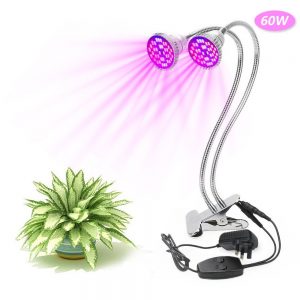
When buying an LED grow lamp, check to see if it has a UK 3 pin plug – some have the 2 pin shaver plug, so you would need an adapter. List of grow lamps here.
Label your tomato seedlings
It is very easy to forget which variety is which, when you grow a lot of plants – especially after potting on.
People send in photos of tomato plants asking me to name the variety, but it can be extremely difficult to tell them apart!
Potting on – when and how
If you sow your seeds in a seed tray, or several in one pot, sow them evenly and as wide apart as possible. Otherwise, when they come through they will be competing for light – if too close together.
The closer they are, the sooner they will need to be transplanted.
My seed tray method
- Sow an inch apart in a seed tray
- Stand seed tray in the sink, to water from below – just a couple of inches of tepid water for a few minutes
- Mist the surface of the soil with water
- Cover with cling film or propagator cover
- Put in a warm place around 21C and after four or five days, inspect them regularly – morning and evening
- I only water once, at the beginning when sowing. By allowing the soil to dry out (almost) makes it much easier to prick out without losing the roots. I’ll leave the seedlings in the seed tray for about three weeks after germination.
Because each variety has its own germination period – some more some less – sow only one variety per seed tray.
We really want tomato seedlings to all come through at the same time. This means we can move them to a light place as soon as the first seedling is through – rather than have some still yet to germinate when we put them into a light area at a lower temperature.
The advantage of having seeds germinating in individual Jiffy pellets and sponges is that we can move them individually to a lighter area as soon as they germinate.
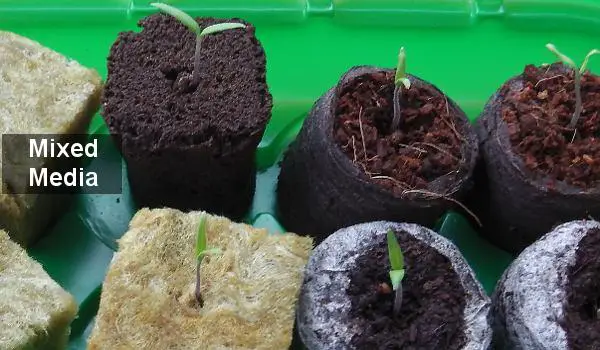
Tap water and pH
If you are using any of the above, it’s good to check the pH of your tap water. This can be done online by visiting the website of your water provider.
Seedlings growing in soilless media prefer a lower pH than mature tomato plants. So if your tap water is high in calcium – and your kettle rattles – a cheap pH test kit (narrow range) and a squirt of lemon juice will do the job just fine!
Seeds growing in seed compost do not require pH adjustment because compost is buffered – not too high, not too low in pH and balanced to provide a suitable medium for seedlings.
Why pH matters
The reason why pH matters is because if it is too high or too low, plants will be unable to absorb all the nutrients they need.
Sluggish growth and/or pale or discoloured leaves can be the result of a pH imbalance when growing in soilless media.
The same problem for soil grown plants in the spring is more likely to be the result of low temperatures.
That’s it for this week on tomato seedlings – went on a bit!
The Oases planter has been reduced in price, so you may want to check it out here.
If you are growing outside this season, I highly recommend growing at least one blight free variety – I’m growing several!
Please leave comments or questions below.
Have a great week!
Regards,
Nick

Rob
Hi Nick,
Thank you for your eagerly awaited newsletter. The season has truly started!
Every year, I lose a few seedlings because the cotyledons seem unable to break through the seed cases. I have tried dropping water onto the seed cases, but with limited success. Do you have any other thoughts please? I would add that I use a heated propagator (therefore high humidity) and the problem is not specific to one variety of tomato. Cheers.
Rob
Nick
Hi Rob, Try adding a drop of washing up liquid to the water you use to moisten the seed shells. Just one or two drops per litre of warm water is all you need.
The soap acts as a surfactant and breaks the surface tension of the water – helps the shell absorb moisture.
Sometimes sowing the seeds deeper and wetting the soil more can help too.
Hope that helps,
Rhys Jaggar
This tip works brilliantly, Nick. Successfully shedded around 30 seed shells by three drops evening, morning then evening. Much quicker than just using water as I have done in the past. Cheers!
Nick
Thanks Rhys for your feedback!
Mick
Thanks Nick.For good info
Nick
You’re welcome!
Rhys Jaggar
You are so right about seedlings and watering, Nick.
I have found that 50ml per 8cm pot once a week to ten days from below is enough for weeks 2-6 (longer wait earlier between waterings, less as the plant gets bigger). It is also how I give my young seedlings their feed of Root-It First Growth (usually 10 days after transplantation to 8cm pots), which has created super healthy plants all three years since you first recommended it here. My trays have six pots each in, so it is 300ml per tray per feed/watering.
I also cannot recommend highly enough adding smidgens of rock dust, friendly bacteria and -fungi into growth medium of young plants: I do it in the medium for 8cm pot transplantation (for me, John Innes Number I), which usually happens on about day 10. Since doing that, I have never had plants struggle and harvests have been earlier and abundant.
I am getting itchy about sowing maincrops!
All the best for a good season…..
Nick
Hi Rhys, It’s good to hear from your experience of watering, feeding seedlings and encouraging friendly bacteria.
All the best for a good season to you too!
Valerie
Nick I shall be moving in a fortnight and it will be Easter before I can sow Tomato seeds.Is there anything I could do to hurry them on? Or will I just end up making lots of chutney?
Nick
HI Valerie, You can sow up to the end of April and expect a good crop before the end of the season. Even the beginning of May with an early and vigorous variety!
From the middle of May plug plants from the garden center are an option.
Rhys Jaggar
Valerie
The key to ripening is not early sowing, rather stopping all watering. Last year I sowed Sungold and Zenith for competions 10-20th September in the first week of April and they were two weeks too early! Continuing to water is actually away to delay ripening, as I learned several years ago through experience!
Sowing on 28th/29th March this year is a really great sowing date – I am sowing many of my maincrops then…..